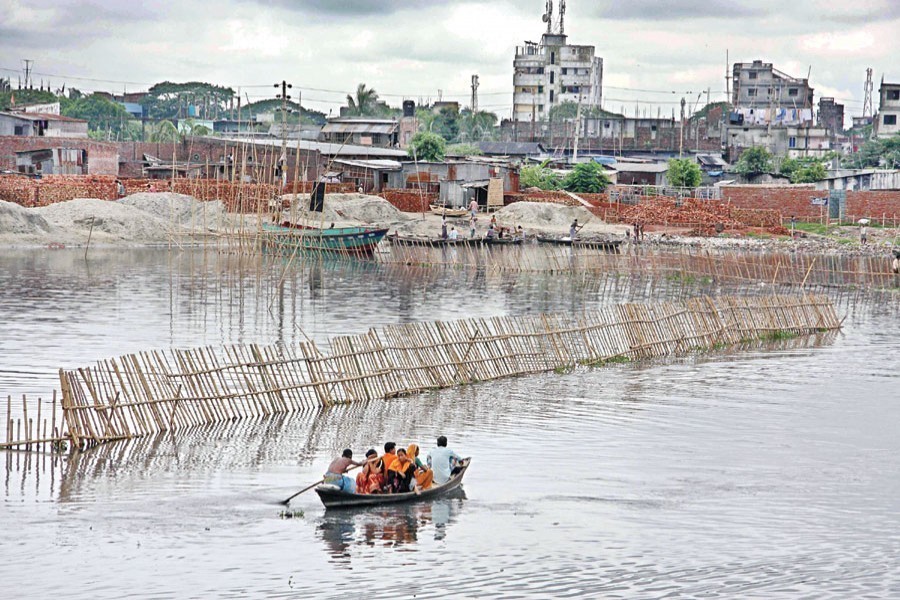Apparently there is hardly any connection or similarity between the glacial burst that triggered a disastrous flash flood in Uttarkhand, India and the tar-like colour of water flowing down the Buriganga River. But a probing eye may discover some common factors that are responsible for the unprecedented change in the glacial rupture and the deterioration of water quality of the river. If the construction of two hydropower dams in the mountainous area with proven seismic agitation could have prompted the glacial meltdown primarily caused by global warming, equally indiscreet human acts are responsible for reducing the Buriganga into a virtual cesspool.
Indeed, aggressive development infrastructure harms natural environment and systems directly and the collective pollution in the form of carbon dioxide gas or effluent or chemical substances like polythene and plastic being released or thrown away indiscriminately expedites the climate change. This sets into motion a process of cause and effects and ultimately a chain reaction beyond human control.
Even the High Court's proclamation for recognising the Buriganga ---in fact every river of the country --- as a living entity has not been respected either by the river grabbers or owners of factories and industries on both sides of its banks and the implementing authorities. The factories and industries releasing untreated harmful effluent have been detected and they were ordered to install effluent treatment plants or otherwise threatened with plugging of releasing points. That nothing substantial has been done so far is clear from the ugly colour and odour of the river's water.
If naked eye can perceive this change in water colour, to realise its long-term impacts there is a need for scientific and environmental studies to determine impacts of development infrastructure. This is truer for big projects like hydro-power dams. Obstruction to natural flow of rivers has its adverse reactions, only more so when infrastructure is built near their place of origin ---one that lies moreover in a seismic zone. The number of infrastructure so built all across the world is not few and their cumulative impact can be disastrous. Both Bangladesh and India have shown interest in one such hydro-power project planned to be built in Nepal, an upper riparian country. The two countries want to import electricity from that plant but perhaps its consequences in environmental terms have not been assessed.
Although a National River Conservation Commission (NRCC) has been constituted with the assignment of identifying river grabbers, problems and prospect of reviving the dead or near-dead rivers as well as protecting the ones in reasonably good health, reports depicting further unleashing of acts of indiscretion on moribund rivers continue to pour in. On Wednesday last, two contemporaries ---one Bangla and another English ---published pictorial reports showing how powerful encroachers and even organisations run by the government mindlessly deliver death blows to rivers. One report shows how sand miners and dredgers have built a road of sands on the Brhmaputra River to carry sands and another presents the encroached site of infrastructure on the river Meghna. There are many such illegal acts causing rivers grievous harms.
All this is happening at a time when the NRCC has been racing against time to save some of the rivers. To its credit the NRCC has been doing its job well and steadfastly. With its limited resources and manpower, it has submitted a list of 57,390 individuals and organisations responsible for illegally occupying river fronts or banks or lands within rivers. Drives against encroachment are still going on. Last year 18, 579 river grabbers were evicted all across the country under the administrative authority of deputy commissioners. But there are downsides like the Ashuganj fertiliser factory that encroached upon the Meghna. Similarly, a member of parliament's establishments built on encroached lands in the Buriganga could not be removed yet. Soft-pedalling on illegal occupation by the privileged and influential players will create a bad precedent.
Then rivers are not the only concern ---although it is a prime one --- for Bangladesh. The glacial bursts spell disasters of cataclysmic proportion. Glaciers, polar ice caps and permafrost are the primal reservoirs of water and they have maintained a balance of water cycles and temperatures depending on the rotation of Earth around the sun. If this balance is disrupted somehow, natural calamities will be the inevitable results.
Already meltdown of polar ice caps and glaciers along with erratic behaviour of permafrost has unfolded nightmarish spectres before the mankind. The prediction is that even if the global community can arrest the Paris climate conference-recommended level at 1.5 degree Celsius above the pre-industrial temperature, one third of the ice in the Hindu Kush Himalayan (HKH) mountain system will melt by this year. Now this does not bode well for the South Asian countries depending on the river system with some of the world's mighty rivers flowing across thousands of miles and providing drinking water and nourishment to lands.
This calls for conservation of the existing rivers and also reviving those already shrunk or are continuing to shrink on account of injudicious acts of man. The NRCC should be empowered sufficiently to deal with the challenges facing the nation due to degradation of rivers.
nilratanhalder2000@ yahoo.com


